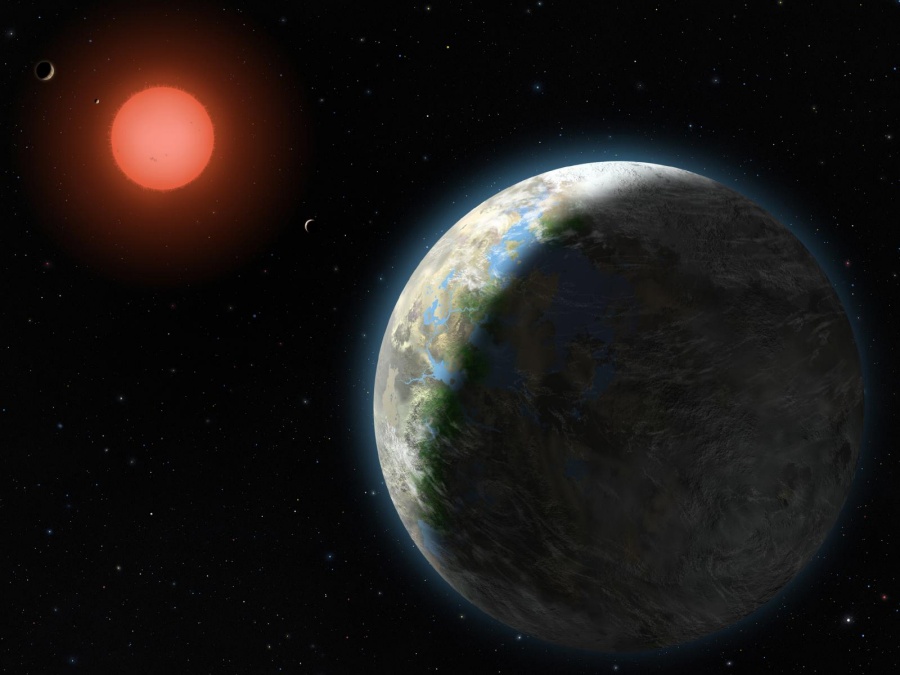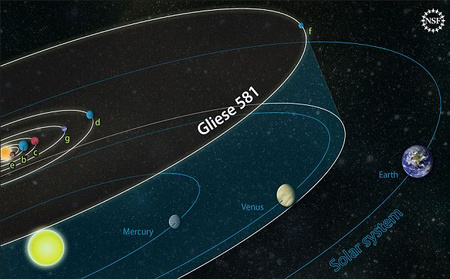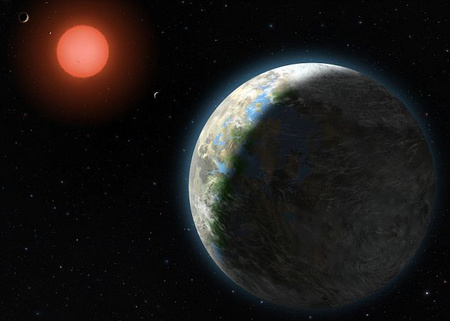Astronomy Picture of the Day
Discover the cosmos! Each day a different image or photograph of our fascinating universe is featured, along with a brief explanation written by a professional astronomer. 2010 October 1
2010 October 1 Illustration Credit & Copyright: Lynette Cook
Föld-szerű bolygó a szomszédunkban
2010. szeptember 30., csütörtök 13:56
Akár folyékony víz és élet is lehet a Gliese 581g-n, állítja egy amerikai kutatócsoport. Az exobolygó az eddigi legígéretesebb Föld-szerű objektum, de még sok mindent csak becsülni tudunk vele kapcsolatban.
A Lick-Carnegie Exoplanet Survey projektben dolgozó amerikai csillagászok szerdán bejelentették, hogy egy Földhöz hasonló kőzetbolygót találtak, amely szerintük akár lakható is lehet. A Kaliforniai Egyetem és a washingtoni Carnegie Intézet kutatói szerint a Gliese 581 nevű vörös törpe egyik bolygója az életre alkalmas zónában van, ami azt jelenti, hogy víz is lehet az objektum felszínén.
A kutatók tanulmánya az Astrophysical Journal következő számában fog megjelenni, a cikk leír két frissen felfedezett bolygót is, amelyeket szintén a Gliese 581 körül találtak. Ezekkel együtt már hat bolygót ismerünk a Gliese 581 mellett, így ez a legjobban feltérképezett bolygórendszer a sajátunk után. A bolygók vagy túl forrók vagy túl hidegek ahhoz, hogy lakhatók legyenek – kivéve a Gliese 581g-t.

A legfényesebb pont a Gliese 581 csillag (képek: nsf.gov)
Akár egy ember is sétálhatna rajta
A csillagászok az úgynevezett radiális sebesség módszerrel figyelték meg a Gliese 581g-t. A radiális sebesség egy tárgy látóirányú sebessége – exobolygók esetében ez a bolygók közeledésének, illetve távolodásának sebességét jelenti a Földhöz képest. Az ilyen nagy radiális sebességű bolygók periodikus változásokat keltenek csillagjuk színképében, ezekből lehet következtetni az exobolygók méreteire és pályáira. Az amerikai csapat Steven Vogt, a Kaliforniai Egyetem csillagászprofesszora vezetésével tizenegy év radiálissebesség-méréseiből számolta ki, milyen lehet a Gliese 581g.
A mérések alapján a bolygó tömege háromszor-négyszer, átmérője pedig 1,2-1,4-szer nagyobb, mint a Földé. A Gliese 581g egyheted csillagászati egységre, azaz körülbelül 22 millió kilométerre van központi csillagától (egy CSE a Nap és a Föld átlagos távolsága). A bolygó 37 nap alatt járja körbe a csillagot, tehát egy év ott alig valamivel több, mint egy földi hónap. A bolygó kozmikus léptékkel nézve itt van a szomszédban: alig húsz fényévre, azaz 189,2 billió kilométerre van a Földtől.

A Gliese 581 bolygóinak elhelyezkedése a Naprendszerhez mérve
Vogték úgy vélik, tömege alapján a bolygó valószínűleg sziklás és elég erős a gravitációja ahhoz, hogy állandó légköre legyen. A felszíni gravitáció nagyjából akkora lehet, mint a Földön (esetleg egy kicsit nagyobb), tehát egy ember könnyedén tudna sétálni a Gliese 581g-n. A kutatók becslése szerint az átlagos felszíni hőmérséklet -31 és -12 Celsius-fok között mozoghat, ami ugyan elég hideg, de nem zárja ki, hogy a helyi körülmények között akár az élet kialakulásához nélkülözhetetlen folyékony víz is legyen a bolygón. A bolygó ugyanis kötött keringésű (akárcsak a mi Holdunk), vagyis mindig ugyanazt az arcát mutatja a csillaga felé. A Gliese 581g örökké napos felén tehát nagyon meleg van, míg az állandó sötétségbe burkolózó oldalán gyilkos hideg.
Még messze az a száz százalék
A felfedezés bejelentésére szervezett sajtótájékoztatón Vogt nagyon lelkesen nyilatkozott. „Tekintve, hogy az élet mindenütt megjelenik, ahol csak tud, a saját személyes megérzésem az, száz százalék az esélye annak, hogy van élet a bolygón” – mondta a sajtótájékoztatón a tudós annak ellenére, hogy a tanulmány óvatosabban és mindenhol feltételes módban fogalmaz a bolygón levő élet lehetőségéről. Vogt kollégája, a Carnegie Intézetet képviselő Paul Butler nem volt hajlandó százalékos becslésekbe bocsátkozni a sajtótájékoztatón, csak annyit mondott, hogy ő is optimista.

Fantáziarajz a Gliese 581g-ről
A lakható, Föld-szerű bolygó az exobolygókutatás Szent Grálja. Korábban már többször is felröppent a hír, hogy megtalálták az első ilyen objektumot – például a Gliese 581c-t is vizsgálták egy időben –, de pontosabb számítások után mindig kiderült, hogy túl zordak a körülmények az élet megjelenéséhez. Bár Vogték szerint a radiálissebesség-mérési módszer pontossága az elmúlt években sokat javult, még a Gliese 581g-ről is kiderülhet, hogy mégsem alkalmas az életre – annak ellenére, hogy az eddig felfedezett, körülbelül négyszáz exobolygó közül eddig valóban ez a legígéretesebb.
„Még nagyon sok itt a bizonytalanság” – kommentálta a hírt megkeresésünkre Kiss László fizikus-csillagász, az MTA Konkoly Thege Miklós Csillagászati Kutatóintézet munkatársa. „A felfedezés hihető és a tanulmány erős lábakon áll, de sok mindent még csak becsülni tudunk. A hőmérsékleti becslések bizonytalansága pedig akár plusz-mínusz ötven fok is lehet. A légkörről pedig még semmit nem tudunk, sőt még egyáltalán nem is pillantottuk meg a bolygót."
A Gliese 581g még csak egy ingadozásként jelentkezik a Gliese 581 csillag fényében, tehát csak közvetett bizonyítékokból számolgatnak a csillagászok. „A következő lépés az lenne, hogy egy iszonyatos nagy távcsövet a bolygóra irányítunk és spektroszkópos megfigyeléseket végzünk" – magyarázta Kiss. „De jelenleg nincs olyan nagy teleszkópunk, ami elég jó lenne erre. A Gliese 581 ugyanis igen halvány, a Napnál sokkal-sokkal kisebb fényteljesítményű vörös törpe, olyan műszer kellene ahhoz, hogy megpillantsuk a bolygóra vetett fényecskéjét, amilyen még nem létezik. Talán majd a következő húsz évben épül olyan távcső, amivel a megfelelő spektroszkópiai vizsgálatok elvégezhetők lesznek, de az az érzésem, hogy ez nem lesz egyszerű mulatság."
A team of planet hunters from the University of California (UC) Santa Cruz, and the Carnegie Institution of Washington has announced the discovery of a planet with three times the mass of Earth orbiting a nearby star at a distance that places it squarely in the middle of the star's "habitable zone."
This discovery was the result of more than a decade of observations using the W. M. Keck Observatory in Hawaii, one of the world's largest optical telescopes. The research, sponsored by NASA and the National Science Foundation, placed the planet in an area where liquid water could exist on the planet's surface. If confirmed, this would be the most Earth-like exoplanet yet discovered and the first strong case for a potentially habitable one.
To astronomers, a "potentially habitable" planet is one that could sustain life, not necessarily one where humans would thrive. Habitability depends on many factors, but having liquid water and an atmosphere are among the most important.
The new findings are based on 11 years of observations of the nearby red dwarf star Gliese 581using the HIRES spectrometer on the Keck I Telescope. The spectrometer allows precise measurements of a star's radial velocity (its motion along the line of sight from Earth), which can reveal the presence of planets. The gravitational tug of an orbiting planet causes periodic changes in the radial velocity of the host star. Multiple planets induce complex wobbles in the star's motion, and astronomers use sophisticated analyses to detect planets and determine their orbits and masses.
"Keck's long-term observations of the wobble of nearby stars enabled the detection of this multi-planetary system," said Mario R. Perez, Keck program scientist at NASA Headquarters in Washington. "Keck is once again proving itself an amazing tool for scientific research."
Steven Vogt, professor of astronomy and astrophysics at UC Santa Cruz, and Paul Butler of the Carnegie Institution lead the Lick-Carnegie Exoplanet Survey. The team's new findings are reported in a paper published in the Astrophysical Journal and posted online at:
"Our findings offer a very compelling case for a potentially habitable planet," said Vogt. "The fact that we were able to detect this planet so quickly and so nearby tells us that planets like this must be really common."
The paper reports the discovery of two new planets around Gliese 581. This brings the total number of known planets around this star to six, the most yet discovered in a planetary system outside of our own. Like our solar system, the planets around Gliese 581 have nearly-circular orbits.
The new planet designated Gliese 581g has a mass three to four times that of Earth and orbits its star in just under 37 days. Its mass indicates that it is probably a rocky planet with a definite surface and enough gravity to hold on to an atmosphere.
Gliese 581, located 20 light years away from Earth in the constellation Libra, has two previously detected planets that lie at the edges of the habitable zone, one on the hot side (planet c) and one on the cold side (planet d). While some astronomers still think planet d may be habitable if it has a thick atmosphere with a strong greenhouse effect to warm it up, others are skeptical. The newly-discovered planet g, however, lies right in the middle of the habitable zone.
The planet is tidally locked to the star, meaning that one side is always facing the star and basking in perpetual daylight, while the side facing away from the star is in perpetual darkness. One effect of this is to stabilize the planet's surface climates, according to Vogt. The most habitable zone on the planet's surface would be the line between shadow and light (known as the "terminator").
Related Links:
› University of California (UC) Santa Cruz
› Carnegie Institution
Teljesen elvetemülteknek íme egy passzentos link, de ezt már csak letölteni lehet:
Nincsenek megjegyzések:
Megjegyzés küldése